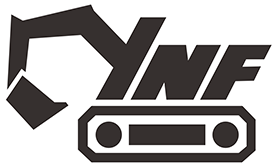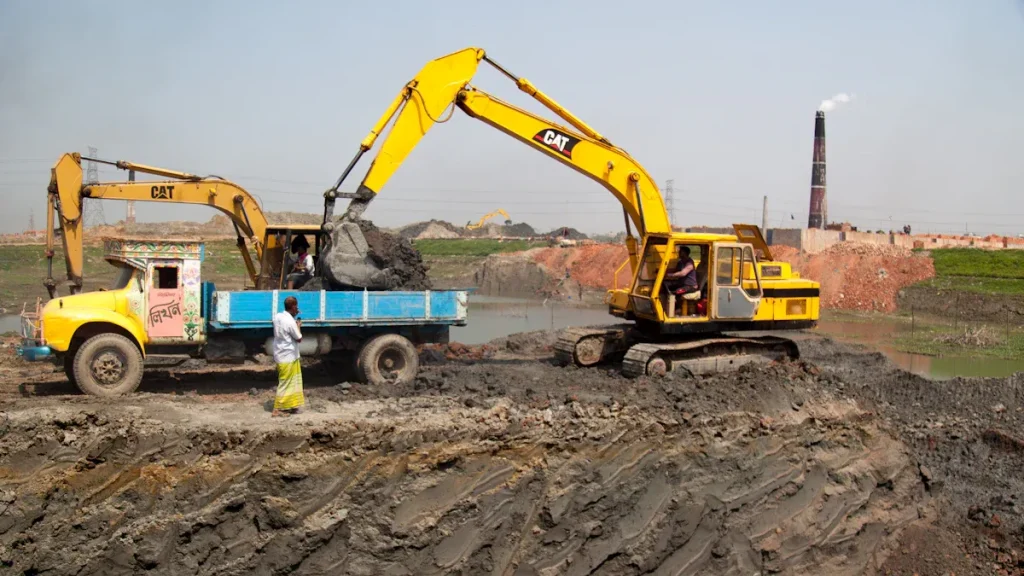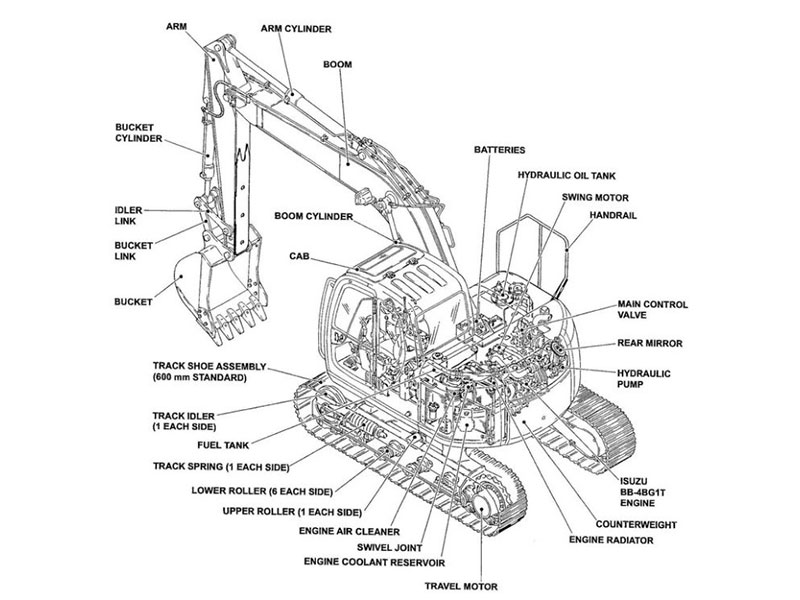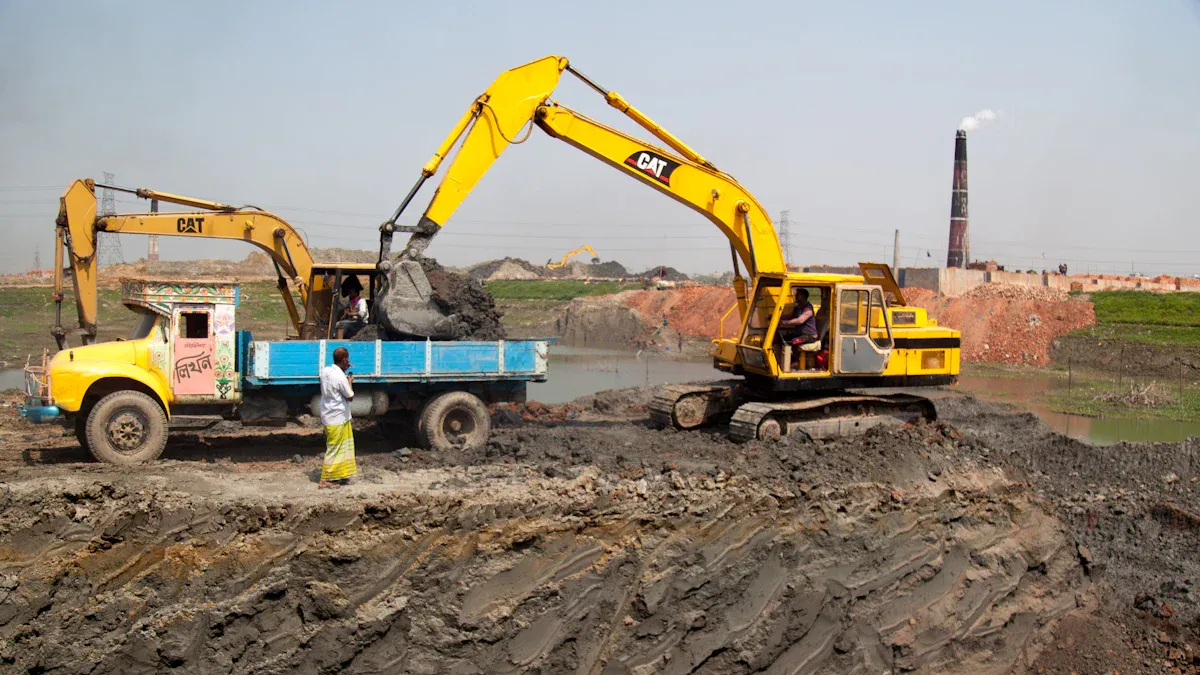
When you use an excavator, you depend on a few main systems to work. The parts of an excavator are split into three big sections. These are the undercarriage, the house, and the arm with its attachments. The undercarriage helps your track excavator stay steady and move on rough ground. The house has the engine, cab, and controls. It is the main part of all excavator parts. The boom, arm, and bucket do the digging and lifting jobs. Look at the table below to see what each part of a track excavator does:
Excavator Section | Primary Function |
|---|---|
Lower Structure (Undercarriage) | Gives ground contact and lets the excavator move using tracks and other parts. |
Upper Structure (House) | Holds the engine, counterweight, operator cabin, and controls. It is the main control center. |
Boom, Arm, and Bucket Components | Do digging, earthmoving, and moving materials by bending and using hydraulic cylinders. |
Knowing the excavator parts list helps you stay safe and keep your machine working well. If you know the parts of an excavator, you can find problems before they get worse.
Key Takeaways
Excavators have three main parts. The undercarriage helps the machine move. The house controls and powers the excavator. The arm and its attachments dig and lift things.
You should check undercarriage parts often. Look at the tracks, rollers, sprockets, and idlers. This keeps your excavator steady. It also helps you avoid expensive repairs.
The house holds the engine, cab, hydraulic system, and counterweight. These are all important for safe and good work.
The arm and attachments include the boom, bucket, and quick coupler. These let you do many jobs safely and fast. You need to use the right tools for each job.
If you know what each part does, you can find problems early. This helps you work safer. It also keeps your excavator working longer.
Excavator Parts List: Undercarriage
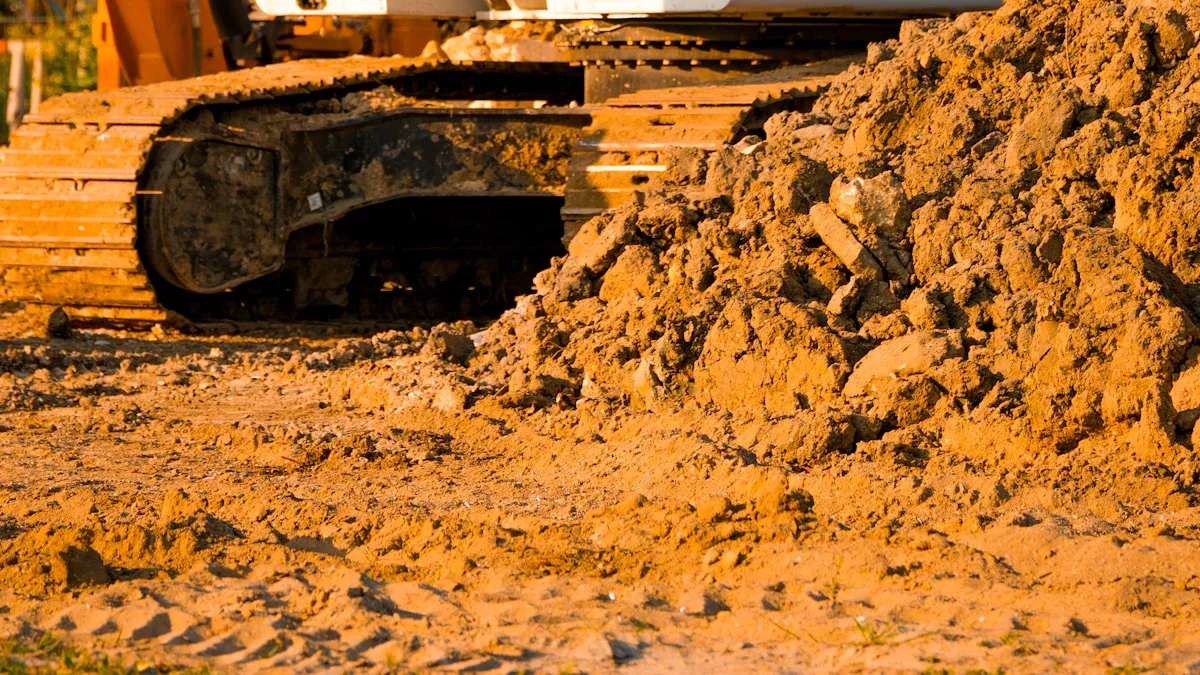
The undercarriage forms the foundation of your track excavator. It supports the entire machine and lets you move across different types of ground. When you understand the excavator parts list for the undercarriage, you can keep your equipment running smoothly and safely. Each part works together to give your excavator stability and mobility.
Tip: Regular checks and maintenance of undercarriage parts help you avoid costly repairs and downtime.
Here is a table that shows the main undercarriage parts and what each one does:
Component | Function |
|---|---|
Tracks | Provide grip and traction, letting you move the excavator over rough or soft ground. |
Track Shoes | Plates that touch the ground, giving extra traction and helping you move forward or backward. |
Track Chains | Hold the track shoes together and allow the tracks to move smoothly. |
Track Rollers | Support the weight of the excavator and guide the track chains as you move. |
Sprockets | Act like gears, turning the track chains so your machine can move. |
Idlers | Guide the tracks and keep them tight, stopping them from slipping off. |
Track Frame | Holds all the undercarriage parts in place and supports the machine’s weight. |
Rock Guards | Protect the tracks and rollers from rocks and debris, reducing damage. |
Tracks
Tracks are the long, continuous bands that wrap around the undercarriage. You use them to move your track excavator across mud, gravel, or uneven ground. Tracks give you the grip and stability you need to work safely. Different types of excavator tracks, like steel or rubber, work better on certain surfaces. For example, steel tracks handle rocky ground, while rubber tracks protect grass or pavement. The right track pattern helps you avoid slipping and reduces wear on your machine.
Note: Choosing the right tracks for your job site improves performance and protects both your excavator and the ground.
Track Rollers
Track rollers sit under the track frame and support the weight of your excavator. They help the tracks roll smoothly as you move. Bottom rollers carry the machine’s weight and keep the tracks in line. Top rollers hold up the track chain and stop it from sagging. You should check your rollers often, especially if you use your excavator every day. Look for cracks, dents, or worn spots. Clean and oil the rollers to keep them working well.
Track rollers spread the weight of your machine, making movement smoother.
They lower the pressure on the ground and help prevent damage to other undercarriage parts.
Regular inspection and care extend the life of your rollers and your whole undercarriage.
Sprockets
Sprockets look like large gears at the back of the undercarriage. They grab the track chains and turn them, moving your excavator forward or backward. Sprockets transfer power from the engine to the tracks. If your sprockets wear out, your tracks may slip or come off. Keeping sprockets in good shape helps your track excavator move safely and efficiently.
Idlers
Idlers are wheels at the front of the undercarriage. They guide the tracks and keep them tight. Idlers help your excavator handle turns and rough ground. They also absorb side impacts when you climb or turn. If the idlers lose tension, your tracks can slip or wear unevenly. Check the idlers often to make sure they keep the tracks tight and moving smoothly.
Idlers keep the tracks in place and help them last longer.
They play a key role in the stability of your excavator undercarriage.
Track Frame
The track frame is the strong metal structure that holds all the undercarriage parts together. It supports the weight of your excavator and keeps everything lined up. The frame also protects the rollers, chains, and other parts from damage. A solid track frame means your machine stays stable, even on rough ground.
Track Chains
Track chains connect the track shoes and let the tracks move around the undercarriage. They carry the weight of your excavator and help you move over different surfaces. Track chains use strong steel links, pins, and bushings to handle heavy loads. You need to check the chains for wear and keep them clean. Well-maintained track chains help your excavator move smoothly and last longer.
Track Shoes
Track shoes are the flat plates attached to the track chains. They touch the ground and give your excavator traction. Wide track shoes work best on soft ground, while narrow ones suit hard surfaces. The right track shoes help you avoid slipping and keep your machine steady.
Rock Guards
Rock guards are protective plates on the sides of the undercarriage. They shield the tracks and rollers from rocks, dirt, and debris. Rock guards help prevent damage and reduce the risk of breakdowns. If you work in rocky or rough areas, rock guards are essential for keeping your excavator parts in good condition.
Remember: The undercarriage supports your entire excavator. It spreads the weight, keeps your machine stable, and lets you move across tough terrain. When you take care of your undercarriage parts, you protect your investment and keep your track excavator working longer.
Parts of an Excavator: House (Upper Structure)
The house sits on top of the undercarriage. It holds many important parts of an excavator. You control the machine from the house. Inside, you find the engine, hydraulic system, and tanks. These parts help your excavator work well. Knowing about these excavator parts helps you stay safe. It also helps you keep your equipment in good shape.
Cab
The cab is where you sit and work. Modern cabs are made for safety and comfort. This helps you work longer and feel less tired. Some cabs have more space for your head and legs. This makes it easier to move around. The controls are easy to reach and use. Seats can be adjusted for comfort. Thick glass and tight seals keep out noise and dust. Special mounts help lower shaking and bumps. Heating and cooling systems keep you comfortable in hot or cold weather. Big windows and cameras help you see all around. This helps you avoid accidents. Emergency exits and bright seat belts keep you safe. Rollover protection helps if the machine tips. Strong filters keep out harmful dust. Some cabs have Bluetooth radios and LED lights. There are also places to store your things.
Tip: A safe and comfy cab helps you work better. Always check your cab before you start working.
Counterweight
The counterweight is at the back of the house. It helps balance the boom and bucket. This keeps your excavator from tipping over. The size and spot of the counterweight are important. A bigger counterweight gives more balance. This is helpful when lifting heavy things. Small excavators may have counterweights you can move or take off. This helps in tight spaces or when moving the machine. The counterweight turns with the house. This keeps you balanced no matter which way you turn.
Engine
The engine gives power to your excavator. It is inside the house. The engine runs all the main systems. When you start it, the engine sends power to the hydraulic pump. It also powers other parts of an excavator. A strong engine helps you dig and lift fast. You should check the oil, filters, and coolant often. Taking care of the engine helps your excavator run well. It also helps you avoid problems.
Hydraulic System
The hydraulic system is very important. It lets you move the boom, arm, and bucket. It also lets you turn the house. Here is how it works: The engine powers a hydraulic pump. The pump pushes oil from a tank. Valves send the oil to different places. Cylinders use the oil to move the boom, arm, and bucket. Motors use the oil to turn the house and move the tracks. Safety valves stop too much pressure. Filters keep the oil clean. An oil cooler keeps the oil at the right heat. The hydraulic system gives you power and control. You can dig deep and lift heavy things. You can also make small, careful moves. Special lines let you use extra tools. Always check for leaks. Keep the oil clean to protect these excavator parts.
Fuel Tank
The fuel tank holds the diesel or gas for your engine. You fill it up before you start work. A full and clean tank keeps your excavator running. Always look for leaks or damage. Dirty fuel can hurt your engine. Use clean fuel and keep the cap tight.
Hydraulic Tank
The hydraulic tank holds oil for the hydraulic system. It keeps the oil clean and at the right amount. If the oil is low or dirty, your excavator will not work well. Check the hydraulic tank often. Change the oil when needed. A good hydraulic tank helps all the moving parts of an excavator work smoothly.
Note: The house has many important parts of an excavator. If you know what each part does, you can find problems early. This helps keep your machine safe and working well.
Excavator Parts: Arm and Attachments
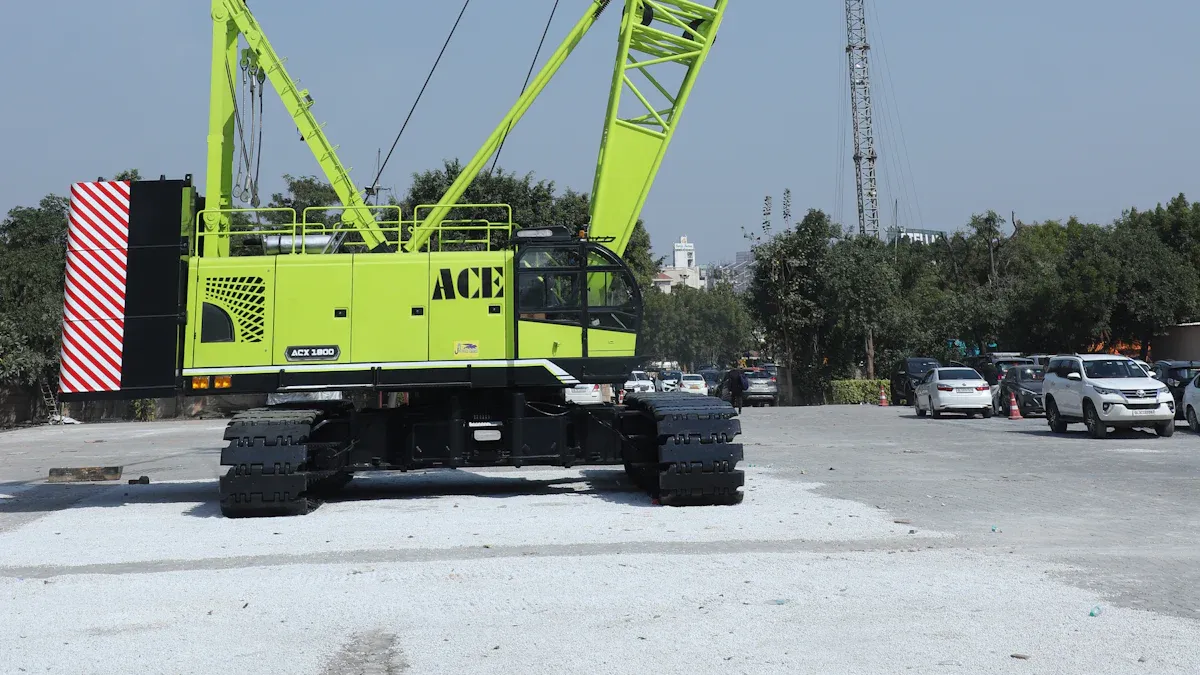
The arm and its attachments give your excavator the power to dig, lift, and handle many jobs. Each part works together to help you move earth, break rocks, or pick up heavy objects. Here is a table that shows the main components and what they do:
Component | Function |
|---|---|
Boom | Connects to the house and supports the arm. Moves up and down to reach high or low spots. |
Arm (Stick) | Connects to the boom and holds the bucket. Controls how far you can reach and how deep you dig. |
Bucket | Attaches to the end of the arm. Digs, scoops, and dumps soil or debris. |
Boom Cylinder | Uses hydraulic power to lift and lower the boom. |
Bucket Cylinder | Moves the bucket for digging or dumping. |
Quick Coupler | Lets you switch attachments fast and safely. |
Attachments | Special tools like clamps, augers, or hammers for different jobs. |
Boom
The excavator boom is the large steel arm that connects to the house. You use it to raise or lower the arm and reach different heights. The boom pivots at its base, giving you a wide range of motion. With the help of the boom cylinder, you can lift heavy loads and dig deep. The boom’s strong design lets you handle tough jobs without bending or breaking.
Tip: Always check the boom for cracks or damage before you start work.
Arm (Stick)
The arm, also called the stick or dipper, attaches to the end of the boom. You use the arm to move the bucket closer or farther from the machine. This helps you control how deep you dig or how far you can reach. The arm works with its own hydraulic cylinder to give you smooth, precise movements.
Bucket
The bucket is the tool at the end of the arm. You use it for digging, scooping, and dumping materials. Buckets come in many shapes and sizes. Some buckets dig trenches, while others clean up debris or grade soil. You can pick the right bucket for your job to work faster and safer.
Boom Cylinder
The boom cylinder is a powerful hydraulic part. It gives you the force to move the boom up and down. This cylinder helps you lift heavy loads and dig deep holes. The boom cylinder keeps your movements smooth and steady, even when you handle tough materials.
Bucket Cylinder
The bucket cylinder controls the bucket’s tilt. You use it to dig, scoop, or dump soil. This cylinder gives you the power to break through hard ground and empty the bucket quickly.
Quick Coupler
A quick coupler lets you change attachments without leaving the cab. You save time and stay safe because you do not need to use tools or extra help. The quick coupler uses strong locks to hold each attachment in place. You can switch from a bucket to a hammer or auger in minutes.
Change attachments fast and safely from inside the cab.
Reduce downtime and labor costs.
Improve job site safety and efficiency.
Attachments (Clamps, Augers, etc.)
Attachments expand what your excavator can do. You can add clamps to grab logs, augers to drill holes, or hammers to break concrete. Each attachment helps you handle special tasks. Pick the right tool for your job to get the best results.
Buckets: Dig, grade, or clean up.
Hydraulic hammers: Break rocks or concrete.
Thumbs: Grab and move odd-shaped objects.
Augers: Drill deep holes for posts or trees.
Grapples: Sort and move debris.
Compactors: Pack soil for building.
Rippers: Tear through hard ground or ice.
Note: Always check that your attachments fit your excavator and are in good shape before you start work.
Knowing the excavator parts list helps you stay safe at work. When you learn what each part does, you can find problems early. This helps your machine last longer. Use the table below to check for safety and good work on any job site:
Excavator Part | Function and Safety Role |
|---|---|
Cabin | Keeps you safe with strong features and clear views. |
Counterweight | Balances your excavator so it does not tip over. |
Undercarriage | Helps your machine move and stay steady, so it breaks less. |
Hydraulic Parts | Make the machine move smoothly and are easy to care for. |
Attachments | Let you pick the best tool for each job, making work safer and faster. |
Learning these words helps you talk with your team. You can do every job with more confidence.
FAQ
What are the most important undercarriage parts to check regularly?
You should check the tracks, rollers, sprockets, and idlers often. These undercarriage parts wear out quickly. Look for cracks, loose bolts, or signs of damage. Regular checks help you avoid breakdowns and keep your excavator safe.
How do you know when to replace an excavator bucket?
You should replace the bucket if you see cracks, worn edges, or missing teeth. A damaged bucket will not dig well. It can also put extra stress on other parts of your machine.
Can you use different attachments on the same excavator?
Yes, you can use many attachments if your excavator has a quick coupler. Always check that the attachment fits your machine. Using the right tool helps you finish jobs faster and safer.
Why does the excavator need a counterweight?
The counterweight keeps your excavator balanced. It stops the machine from tipping when you lift heavy loads. You should never remove the counterweight unless the manual says it is safe.
How often should you check the hydraulic system?
You should check the hydraulic system every day before you start work. Look for leaks, low oil, or dirty filters. Clean oil and working parts help your excavator run smoothly.
